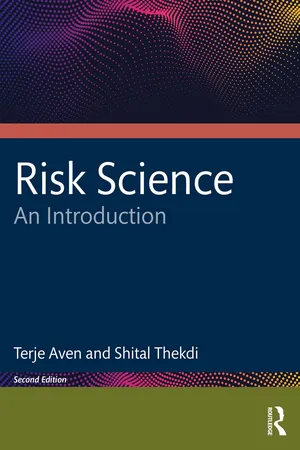
- 448 pages
- English
- ePUB (mobile friendly)
- Only available on web
About This Book
Risk science is becoming increasingly important as businesses, policymakers and public sector leaders are tasked with decision-making and investment using varying levels of knowledge and information. Risk Science: An Introduction explores the theory and practice of risk science, providing concepts and tools for understanding and acting under conditions of uncertainty.
The chapters in this book cover the fundamental concepts, principles, approaches, methods and models for how to understand, assess, communicate, manage and govern risk. These topics are presented and examined in a way which details how they relate, for example, how to characterize and communicate risk with particular emphasis on reflecting uncertainties; how to distinguish risk perception and professional risk judgments; how to assess risk and guide decision-makers, especially for cases involving large uncertainties and value differences; and how to integrate risk assessment with resilience-based strategies. The text provides a variety of examples and case studies that relate to highly visible and relevant issues facing risk academics, practitioners and non-risk leaders who must make risk-related decisions.
This revised and updated second edition features an entirely new chapter on the integrity and quality of risk studies, and dealing with misinformation in the context of risk. Presenting both the foundational and most recent advancements in the subject matter, this work particularly suits students of risk science courses at college and university level. The book also provides broader key reading for students and scholars in other domains, including business, engineering and public health.
Frequently asked questions
Information
Table of contents
- Cover
- Half Title
- Title Page
- Copyright Page
- Table of Contents
- About the authors
- Preface to the first edition
- Preface to the second edition
- Acknowledgments
- Key symbols
- 1 Illustrative examples
- 2 What is risk?
- 3 Measuring and describing risk
- 4 Basic theory of risk assessment
- 5 More on risk assessment methods
- 6 Risk perception
- 7 Risk communication
- 8 Basic theory of risk management
- 9 Methods for balancing different concerns: Decision and cost-benefit analysis
- 10 General knowledge and experience
- 11 Integrity and quality of risk studies: Misinformation
- 12 Cases: Personal, organizational and public
- Appendices
- References
- Index